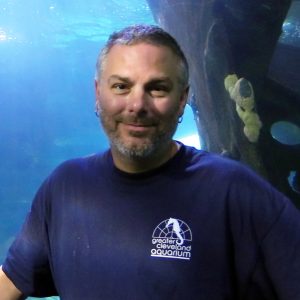Best Places to Dive: The Ghost Fleet of Truk Lagoon, Federated States of Micronesia
 “Growing up, we learn about history through books. We even get to take trips and see battlefields, buildings, and relics. Few of us ever get to see the evidence, examine it, lay eyes on the details and the human element,” begins Mike Gorek. Mike is Senior Maintenance Engineer at Greater Cleveland Aquarium, and we like to say that he’s been here since before we had water. He’s talking about a remarkable dive trip – a liveaboard at Chuuk Lagoon in Micronesia.
“Growing up, we learn about history through books. We even get to take trips and see battlefields, buildings, and relics. Few of us ever get to see the evidence, examine it, lay eyes on the details and the human element,” begins Mike Gorek. Mike is Senior Maintenance Engineer at Greater Cleveland Aquarium, and we like to say that he’s been here since before we had water. He’s talking about a remarkable dive trip – a liveaboard at Chuuk Lagoon in Micronesia.
“It was a vacation. I got to live on a boat in the middle of nowhere in a country that few people know exists, and fewer could find on a map. Unfortunately for the people of Chuuk, the Imperial Japanese Navy were aware of their existence and went above and beyond to impose their will on the natives of these islands, all for strategic advantage for the Pacific,” says Gorek.
A little background about the island nations of the Western Pacific: Micronesia is a subregion in Oceania consisting of over 2,100 small islands and consists of four main island groups: the Mariana Islands (which includes Guam, the largest island in the region), the Marshall Islands (site of 24 nuclear tests at Bikini Atoll by the United States in the 1940s and 50s), the Gilbert Islands, and the Caroline Islands, which includes the Federated States of Micronesia (FSM). These island chains are no strangers to colonialism, and FSM was captured by Japan in World War I. During World War II, Chuuk Lagoon served as the Empire of Japan’s naval base in the South Pacific theater. It can be confusing, but Chuuk refers to the state and the land, Truk refers to the lagoon and dive sites. In February of 1944, just over two years after Pearl Harbor, the United States Navy launched Operation Hailstone to take out the Japanese fleet.
“In the wee hours of February 17th into the 18th, American forces decimated the Japanese fleet. Over 250 aircraft and north of 50 ships were destroyed and/or sent to their resting place on the bottom of the ocean,” Mike says about Hailstone. A generation later, this site of incredible carnage lures wreck divers from around the world. I’ll let Mike tell it.
“For a week some 59 years (after the attack), I stepped aboard the Odyssey to dive the wrecks of Truk Lagoon. We landed on a short runway where, from the plane, there’s no visible land and your luggage is dumped through a hole in the wall with a front-end loader. There were 25 dives over six-and-a-half days, most surpassing 30 meters, culminating with the San Francisco Maru. (Its deck is 165 feet and, while passing through the cargo hold at 186 feet, we still hadn’t reached bottom.) Most of the ships we encountered were merchant ships converted to military use for the Imperial Japanese Navy.
The thing about war you never see is the human element, in this case, sake bottle after sake bottle, medical tools, gas masks, rubber boots, tile latrines and the head on the boats, tools, air compressors, and gauges stuck in their resting places. But beyond any of these relics were human remains themselves—femur bones on an operating table or even a human skull. All these things littered these wrecks through the mid-1980s, though less these days. Ships that stood proud and tall, are now reduced to fields of soft coral playing home to fish, crab, octopus and everything else you can possibly think of.
There were cargo holds filled with trucks, motorcycles, Japanese Zeros and an abundance of surplus parts . . . all just frozen in time. Periscopes on a submarine tender, bulldozers encrusted to steel, waiting for their opportunity. What was really astounding, the biggest take away, was the raw power of black powder. We crawled through two-inch think plated steel mangled from a torpedo blast.”
Initially explored in 1969 by legendary oceanographer Jacques Cousteau and often referred to as the “Ghost Fleet of Truk Lagoon”, Chuuk Lagoon is now known as the world’s greatest collection of diveable World War II Japanese shipwrecks.
The Ghost Fleet of Truk Lagoon is the tenth and final in our series of the Aquarium dive team’s favorite dive locations. Thank you for all the readers who’ve kept up and those who come back to the series. If your destination wasn’t on our list, suggest somewhere new we might want to explore.
- Ray D.
